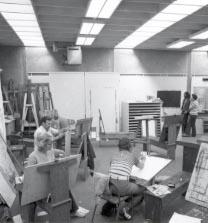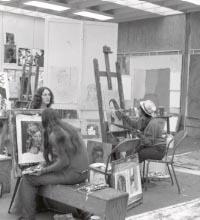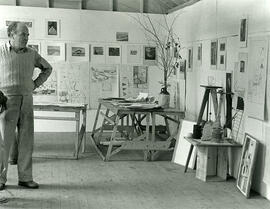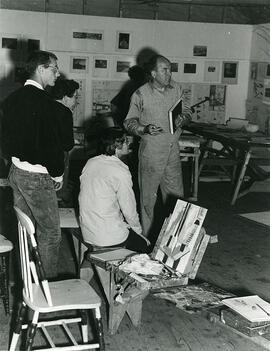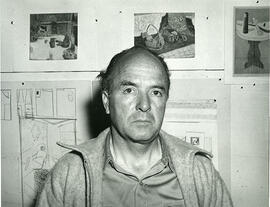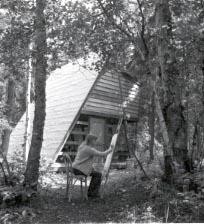Showing 78 results
Archival description39 results with digital objects Show results with digital objects
Emma Lake Art Camp - Dining Hall - Interior
- A-8726
- Item
- Aug. 1964
View of the empty interior of the dining hall.
Emma Lake Art Camp - Students - Class in Session
- A-8732
- Item
- 1941
Students at work in the studio. Text on the original page reads: "Art from all angles The First - or second - or third day".
Emma Lake Art Camp - Scrapbook - Illustration
- A-8737
- Item
- 1941
One of several pen and ink and watercolour illustrations in the scrapbook by C.J. Uglem. This pages documents July 27 and the Symphony.
Bio/Historical Note: Perhaps the artist is [Clarence J. Uglem, born in 1917, died in 1968 at age 50, and is buried in Swift Current, Saskatchewan].
Emma Lake Art Camp - Scrapbook - Illustration
- A-8740
- Item
- 1941
One of several pen and ink and water colour illustrations in the scrapbook by C.J. Uglem. This pages documents August 13 and the Faery Island Picnic.
Bio/Historical Note: Perhaps the artist is [Clarence J. Uglem, born in 1917, died in 1968 at age 50, and is buried in Swift Current, Saskatchewan].
Emma Lake Art Camp - Sketchbook - Sketch
- A-8752
- Item
- 1937
One of 28 charcoal sketches in the book drawn by students in the summer of 1937. Signed 'H.M. Palsson.'
Bio/Historical Note: Artist workshops have been held at Emma Lake, Saskatchewan, since 1935. Augustus F. (Gus) Kenderdine, an artist trained at the Academie Julian in Paris and an instructor in the fledgling Department of Art at the University of Saskatchewan, established a summer art camp on an eleven-acre boreal forest peninsula on the shores of Emma Lake. He convinced Walter C. Murray, first president of the University of Saskatchewan, that the art camp could perform a vital role in the offerings of the department, and in 1936 the Murray Point Art School at Emma Lake was officially incorporated as a summer school program. The school was also known as the art colony. Participants were teachers and artists who came from all over the province to learn how to teach art in Saskatchewan schools. After Kenderdine's death in 1947, a new generation of Saskatchewan artists came of age or moved into the province, including Kenneth Lochhead, Arthur McKay, Ronald Bloore, Ted Godwin, and Douglas Morton, popularly referred to as the Regina Five. In 1955 Lochhead, director of the Regina College School of Art, proposed a two-week workshop at Emma Lake to follow the Murray Point Art School classes. The workshop concept, based on modernist art, was established to keep Prairie artists in touch with art centers such as New York and Toronto. The internationally renowned Emma Lake Artists' Workshops became an established annual event and continued virtually unchanged until the last workshop was held in 1995. Since the mid-1960s the site has also been a provincial research area under the auspices of the U of S Department of Biology for biologists and other researchers. It is the most northerly field station in Saskatchewan and one of the few sites in Canada that specifically examines the boreal forest. It was declared as a game preserve in 1962. In 1989 the site was officially designated as Emma Lake Kenderdine Campus in recognition of Gus Kenderdine. The campus closed in 2012. In 2020 the university relocated nearly two dozen cabins at the site to Montreal Lake Cree Nation to provide additional housing during the COVID-19 pandemic.
- A-8763
- Item
- 1941
Cover of the 1941 calendar.
Emma Lake Art Camp - Students - Class in Session
- A-9492
- Item
- Aug. 1964
Students at work in the campus studio.
Emma Lake Artists' Workshop - Jack Shadbolt
- A-3891
- Item
- 1955
Jack Shadbolt, first guest artist at the inaugural Emma Lake Artists' Workshop, stands alone in the studio.
Bio/Historical Note: Kenneth Lochhead and Arthur McKay, professors at the University of Saskatchewan, Regina Campus (now called the University of Regina since 1974) initiated the Emma Lake Artists' Workshops in 1955.
Bio/Historical Note: Jack Leonard Shadbolt was born 4 February 1909 at Shoeburyness, England. In 1912 the family moved to British Columbia, eventually settling in Victoria. In the late 1920s, after studying at the Victoria College and Normal School, he met Emily Carr. "I was dumbstruck with admiration," Shadbolt later said. Carr's renderings of Northwest Coast Indian symbols eventually led to Shadbolt's own exploration of aboriginal images. But at this time, his paintings focused on what he called the "dark, satanic mills" of industrial landscape. Shadbolt studied at the Art Students' League in New York City (1948) and in London (1937) and Paris (1938). After teaching art to children in BC between 1929 and 1937, he joined the Vancouver School of Art. During 1944-1945 Shadbolt was assigned to the official Canadian Army war artists program in London. One of his jobs was sorting through army photographs of concentration camps. Looking at still lifes of emaciated bodies, then roaming around bombed-out London, had a profound psychological impact on the artist. After the war Shadbolt returned to the school, where he was head of painting and drawing until 1966. He was an influential teacher and adviser across Canada and the US, having conducted workshops (he was the first artist to do so at the Emma Lake Artists' Workshops in 1955) and juried exhibitions throughout North America. Some 70 solo exhibitions of Jack Shadbolt's work were mounted and his many major international exhibitions included the Venice Biennale XXVIII and 4 major retrospective exhibitions at the Vancouver Art Gallery, the BC Museum of Anthropology, the National Gallery of Canada and the Glenbow Museum. An extraordinarily prolific artist, Shadbolt worked in large series (or suites) which derived from his personal experiences of nature and Native art in BC, his many travels in Europe and his recognition of calligraphy and op-art; in paint slashes and in incisive lines, in butterflies and totem poles, in insect life and ritual brides, in poetry and architecture. As well as painting many murals (Edmonton International Airport, the National Arts Centre and the former CBC building), he did stage, ballet and costume designs and theatre posters. Shadbolt authored In Search of Form (1968), Mind's I (1973) and Act of Art (1981). Until his death, he continued to have an enormous output, such as the 3-dimensional plywood relief created for the MacMillan Bloedel building in Vancouver (1987). In 1988 he and his wife, Doris (nee Meisel), started VIVA, the Vancouver Institute for Visual Arts, which offered monetary awards to local visual artists - two yearly $10,000 awards and one $50,000 every fifth year. He also supported Artists for Kids Trust, generating $500,000 to assist Vancouver-area students. Among many honours was the appointment as Officer of the Order of Canada in 1972. At the time of his death, Shadbolt was planning a new show for February 1998. Jack Shadbolt died 22 November 1998 in Burnaby, British Columbia, at age 89.
Emma Lake Artists' Workshop - Jack Shadbolt
- A-3893
- Item
- 1955
Jack Shadbolt, first guest artist at the inaugural Emma Lake Artists' Workshop, lectures as three students look on.
Bio/Historical Note: Kenneth Lochhead and Arthur McKay, professors at the University of Saskatchewan, Regina Campus (now the University of Regina) initiated the Emma Lake Artists' Workshops in 1955.
Emma Lake Artists' Workshop - Jack Shadbolt
- A-3898
- Item
- 1955
Head and shoulders image of Jack Shadbolt, first guest artist at the inaugural Emma Lake Artists Workshop.
Bio/Historical Note: Kenneth Lochhead and Arthur McKay, professors at the University of Saskatchewan, Regina Campus (now called the University of Regina since 1974) initiated the Emma Lake Artists' Workshops in 1955.
Bio/Historical Note: Jack Leonard Shadbolt was born 4 February 1909 at Shoeburyness, England. In 1912 the family moved to British Columbia, eventually settling in Victoria. In the late 1920s, after studying at the Victoria College and Normal School, he met Emily Carr. "I was dumbstruck with admiration," Shadbolt later said. Carr's renderings of Northwest Coast Indian symbols eventually led to Shadbolt's own exploration of aboriginal images. But at this time, his paintings focused on what he called the "dark, satanic mills" of industrial landscape. Shadbolt studied at the Art Students' League in New York City (1948) and in London (1937) and Paris (1938). After teaching art to children in BC between 1929 and 1937, he joined the Vancouver School of Art. During 1944-1945 Shadbolt was assigned to the official Canadian Army war artists program in London. One of his jobs was sorting through army photographs of concentration camps. Looking at still lifes of emaciated bodies, then roaming around bombed-out London, had a profound psychological impact on the artist. After the war Shadbolt returned to the school, where he was head of painting and drawing until 1966. He was an influential teacher and adviser across Canada and the US, having conducted workshops (he was the first artist to do so at the Emma Lake Artists' Workshops in 1955) and juried exhibitions throughout North America. Some 70 solo exhibitions of Jack Shadbolt's work were mounted and his many major international exhibitions included the Venice Biennale XXVIII and 4 major retrospective exhibitions at the Vancouver Art Gallery, the BC Museum of Anthropology, the National Gallery of Canada and the Glenbow Museum. An extraordinarily prolific artist, Shadbolt worked in large series (or suites) which derived from his personal experiences of nature and Native art in BC, his many travels in Europe and his recognition of calligraphy and op-art; in paint slashes and in incisive lines, in butterflies and totem poles, in insect life and ritual brides, in poetry and architecture. As well as painting many murals (Edmonton International Airport, the National Arts Centre and the former CBC building), he did stage, ballet and costume designs and theatre posters. Shadbolt authored In Search of Form (1968), Mind's I (1973) and Act of Art (1981). Until his death, he continued to have an enormous output, such as the 3-dimensional plywood relief created for the MacMillan Bloedel building in Vancouver (1987). In 1988 he and his wife, Doris (nee Meisel), started VIVA, the Vancouver Institute for Visual Arts, which offered monetary awards to local visual artists - two yearly $10,000 awards and one $50,000 every fifth year. He also supported Artists for Kids Trust, generating $500,000 to assist Vancouver-area students. Among many honours was the appointment as Officer of the Order of Canada in 1972. At the time of his death, Shadbolt was planning a new show for February 1998. Jack Shadbolt died 22 November 1998 in Burnaby, British Columbia, at age 89.

